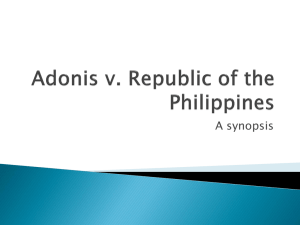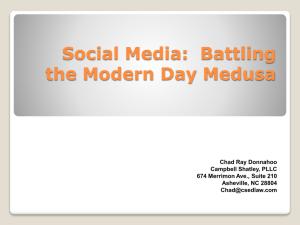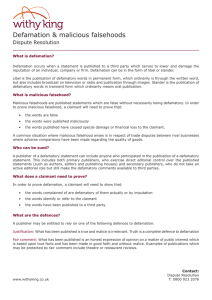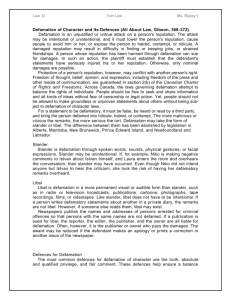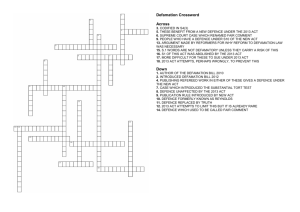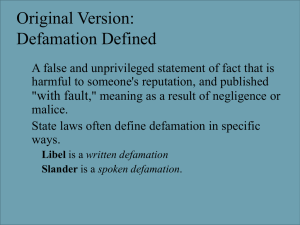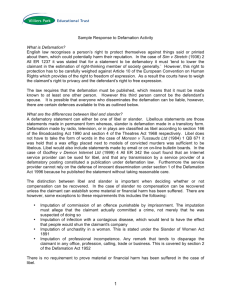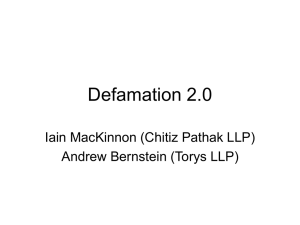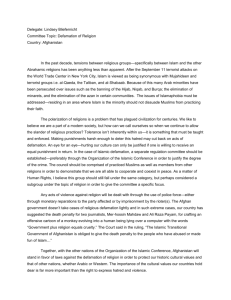Unintentional defamation
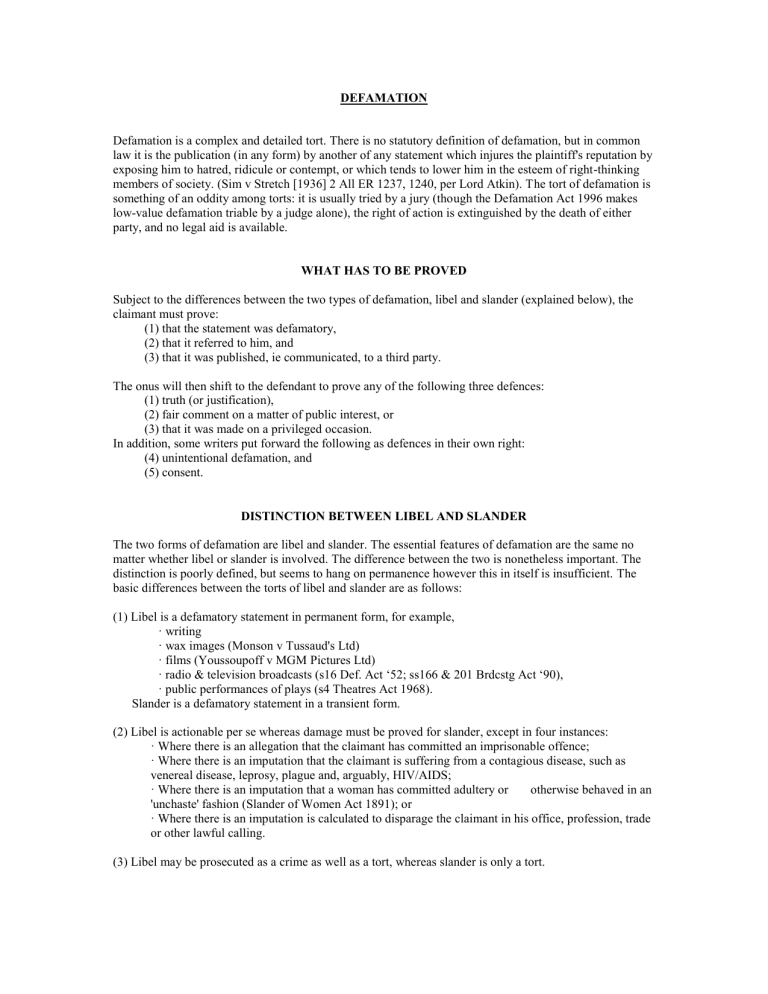
DEFAMATION
Defamation is a complex and detailed tort. There is no statutory definition of defamation, but in common law it is the publication (in any form) by another of any statement which injures the plaintiff's reputation by exposing him to hatred, ridicule or contempt, or which tends to lower him in the esteem of right-thinking members of society. (Sim v Stretch [1936] 2 All ER 1237, 1240, per Lord Atkin). The tort of defamation is something of an oddity among torts: it is usually tried by a jury (though the Defamation Act 1996 makes low-value defamation triable by a judge alone), the right of action is extinguished by the death of either party, and no legal aid is available.
WHAT HAS TO BE PROVED
Subject to the differences between the two types of defamation, libel and slander (explained below), the claimant must prove:
(1) that the statement was defamatory,
(2) that it referred to him, and
(3) that it was published, ie communicated, to a third party.
The onus will then shift to the defendant to prove any of the following three defences:
(1) truth (or justification),
(2) fair comment on a matter of public interest, or
(3) that it was made on a privileged occasion.
In addition, some writers put forward the following as defences in their own right:
(4) unintentional defamation, and
(5) consent.
DISTINCTION BETWEEN LIBEL AND SLANDER
The two forms of defamation are libel and slander. The essential features of defamation are the same no matter whether libel or slander is involved. The difference between the two is nonetheless important. The distinction is poorly defined, but seems to hang on permanence however this in itself is insufficient. The basic differences between the torts of libel and slander are as follows:
(1) Libel is a defamatory statement in permanent form, for example,
· writing
· wax images (Monson v Tussaud's Ltd)
· films (Youssoupoff v MGM Pictures Ltd)
· radio & television broadcasts (s16 Def. Act ‘52; ss166 & 201 Brdcstg Act ‘90),
· public performances of plays (s4 Theatres Act 1968).
Slander is a defamatory statement in a transient form.
(2) Libel is actionable per se whereas damage must be proved for slander, except in four instances:
· Where there is an allegation that the claimant has committed an imprisonable offence;
· Where there is an imputation that the claimant is suffering from a contagious disease, such as venereal disease, leprosy, plague and, arguably, HIV/AIDS;
· Where there is an imputation that a woman has committed adultery or otherwise behaved in an
'unchaste' fashion (Slander of Women Act 1891); or
· Where there is an imputation is calculated to disparage the claimant in his office, profession, trade or other lawful calling.
(3) Libel may be prosecuted as a crime as well as a tort, whereas slander is only a tort.
Jones v Jones [1916] 2 AC 481, HL
A woman D alleged orally that a teacher P had committed adultery with the school cleaner on school premises, but P's action for slander did not assert special damage. Affirming the Court of Appeal and finding for D, the House of Lords said that although P would have been liable for dismissal if the allegations had been proved, the allegation was not directed against him as a schoolmaster per se. (N.B. If it had been an allegation of fornication with a pupil, the outcome might well have been different).
[Note that: The Defamation Act 1952 states expressly in s.1 that defamation contained in any radio or TV broadcast is to be treated as libel, and s.4 of the Theatres Act 1968 similarly gives the status of libel to defamatory words spoken in the course of a play in performance. The status of skywriting is the subject of a "Misleading Case" by Sir Alan Herbert, but seems to be undecided.]
FUNCTION OF JUDGE AND JURY
All actions for defamation must be commenced in the High Court, and it is one of the few civil actions that are still tried with juries. The Civil Procedure Rules have not removed this right:
Safeway plc v Tate [2001] The Times LR 25 January
It is the function of the judge to decide if the words were capable of being defamatory in the eyes of a reasonable person: (a) If the judge rules that no reasonable person would actually conclude that the words in question were defamatory, the case will fail at that point; (b) If the judge rules that the words are capable of being defamatory in the eyes of a reasonable person, the words will be put to the jury and the judge will ask them to decide whether the words were defamatory (Lewis v Daily Telegraph [1964] AC 234).
[Note that by s7 of the Defamation Act 1996, the court shall not be asked to rule whether a statement is arguably capable, as opposed to capable, of bearing a particular meaning or meanings attributed to it.]
Juries also decide the amount of damages to be awarded to the claimant. It is well established that jury awards for defamation are excessive, especially when compared to judicial awards for personal injuries.
The Court of Appeal now has the power to substitute an award of damages instead of ordering a new trial in cases where the damages awarded are excessive or inadequate (s8 Crts & Leg. Serv.s Act 1990).
ESSENTIALS OF DEFAMATION
(1) WORDS MUST BE DEFAMATORY
The statement must be defamatory. According to Lord Atkin, the statement must tend to lower the claimant in the estimation of right-thinking members of society generally, and in particular cause him to be regarded with feelings of hatred, contempt, ridicule, fear and disesteem. However, this rule is by no means as simple and straightforward as it seems. There is room for considerable disagreement as to what right-thinking people would think in a particular situations, and some of the decisions seem rather odd in the modern world. (Sim v Stretch [1936] 2 All ER 1237).
Mere abuse
The requirement that the statement should be defamatory excludes mere vulgar abuse (in speech, though probably not in words) which is understood as such. To call someone a "silly bugger" is on its face an allegation that he has committed a serious criminal offence, but if these words were spoken between friends, or in the course of an argument, a jury would surely conclude that they were mere abuse and not intended to reflect upon P's public reputation. Hence, vulgar abuse is not defamatory. As Mansfield CJ put it in Thorley v Kerry: "For mere general abuse spoken no action lies." According to Winfield & Jolowicz spoken words which are prima facie defamatory are not actionable if it is clear that they were uttered merely as general vituperation and were so understood by those who heard them. Further, the same applies to words spoken in jest (Donoghue v Hayes.
Innuendo
Whether words are defamatory may depend on the plaintiff's circumstances. Sometimes a statement may not be defamatory on the face of it but contain an innuendo, where an apparently innocent statement takes on a defamatory meaning because of the surrounding circumstances. The person making an assertion does so at his peril: it makes no difference whether he knows of the circumstances giving his otherwise innocent statement a defamatory meaning. If those circumstances exist, and a foreseeable hearer or reader of the statement is aware of them, that is sufficient to make such a statement actionable. Note that the hidden meaning must be one that could be understood from the words themselves by people who knew the claimant and must be specifically pleaded by the claimant.
Cassidy v Daily Mirror [1929] 2 KB 331, CA
A newspaper published a picture of C together with a young woman P, and described them in the caption as
"C and 'Miss X', whose engagement has been announced". P was in fact C's lawful wife, and sued for libel in the implication that she was currently living with C as his mistress. The jury awarded her œ500 and the
Court of Appeal dismissed DD's appeal. Liability for libel, said Russell LJ, does not depend on the intention of the defamer but on the fact of defamation.
Lewis v Daily Telegraph [1963] 2 All ER 151, HL
A newspaper reported that the Fraud Squad were investigating the affairs of a company, and the company chairman sued for libel by the implication that he was guilty of fraud. By majority decisions in both the
Court of Appeal and the House of Lords, it was held that the words in the report were not capable of bearing the meaning alleged: to say that someone is suspected of being fraudulent is not the same as saying that they are fraudulent, and the jury are not entitled to infer the second as a meaning of the first.
Charleston v News Group Newspapers [1995] 2 All ER 313, HL
PP were actors appearing in the TV programme Neighbours. DD printed an article about computer pornography, illustrating what was possible by superimposing PP's heads on the bodies of models engaged in sexual activities. The text of the article made clear what had been done, but the headline and picture taken in isolation made it appear that PP were acting indecently, and PP sued for libel. Blofeld J held that the article taken as a whole was not capable of having the defamatory meaning alleged by PP, and PP's appeals were dismissed by the Court of Appeal and House of Lords. The article must be taken as a whole, and as such it was clearly not defamatory. (Whether the typical tabloid reader would in fact have read the whole article is another matter entirely!)
(2) REFERENCE TO THE CLAIMANT
The second requirement is whether the statement refers to the plaintiff i.e. whether it identifies him or her directly or indirectly. Often this is obvious and undisputed, but where it is not a similar test to that discussed above applies. The question is whether an ordinary person reading or hearing the statement, and perhaps applying ordinary loose thinking, might reasonably think that it does. The courts have sometimes taken a very broad approach to this question.
Defamation of a class
If a class of people is defamed, there will only be an action available to individual members of that class if they are identifiable as individuals. Per Willes J in Eastwood v Holmes "If a man wrote that all lawyers were thieves, no particular lawyer could sue him unless there was something to point to the particular individual."
If the defendant made a reference to a limited group of people, eg the tenants of a particular building, all will generally be able to sue.
Unintentional defamation
At common law it was irrelevant that the defendant did not intend to refer to the claimant. Section 4 of the
Defamation Act 1952 provided a special statutory defence in cases of 'unintentional defamation', by allowing the defamer to make an 'offer of amends' by way of a suitable correction and apology and may include an agreement to pay compensation and costs. The defence is now contained in ss2-4 of the
Defamation Act 1996, which was an attempt to modernise the law. The person accepting the offer may not bring or continue defamation proceedings. If the offer to make amends fails, the fact that the offer was
made is a defence and may also be relied on in mitigation of damages. A publication made 'malicously'
(spitefully, or with ill-will or recklessness as to whether it was true or false) will destroy the defence of unintentional defamation.
Hulton v Jones [1910] AC 20, HL
AA published in their newspaper a humorous article describing the misdeeds in Dieppe of a purely fictitious "Artemus Jones, a churchwarden from Peckham". A barrister Artemus Jones, who was not a churchwarden, did not live in Peckham, and had never been to Dieppe, sued for libel, alleging that his friends took the article to refer to him. The Court of Appeal and House of Lords upheld the jury's finding in
R's favour.
Newstead v London Express [1939] 4 All ER 319, CA
DD published a report that Harold Newstead, a 30-year-old Camberwell man, had been convicted of bigamy. Another man of the same name and age, also living in Camberwell, sued for libel and claimed the report could be taken as referring to him. The jury agreed that the words were defamatory, but could not agree whether or not a reasonable person could have taken them as referring to P, and Hawke J did not enter judgement but left it to P to reopen the case if he wished. DD's appeal was dismissed; the Court of
Appeal said the case had been properly left to the jury, and they might reasonably have found that the report could be taken as referring to P.
Note:
A corporate legal person such as a company can sue for defamation on essentially the same terms as a natural person, but this does not apply to unincorporated associations. Nor does it extend to elected public bodies, since the public interest in free speech in a democratic society is taken to outweigh the interests of the corporate body. An individual politician or political candidate, of course, can still bring an action for defamation if he can be identified in material published about his party.
(3) PUBLICATION
No defamatory statement can do anything to affect P's reputation until it is published (i.e. communicated) to and understood by some person other than P himself. Publication need not be widespread, but there is no publication if the statement is made only to D's spouse, or if it is made in the course of legal proceedings. P has the burden of proving publication, but the law makes rebuttable presumptions of publication in respect of open postcards and properly addressed letters. If the hearer repeats the statement to another party there is a further publication, for which D is liable if a) he authorised or intended such repetition, b) the hearer had a legal or moral duty to repeat it, or c) it was a natural and probable consequence of the original publication. However, D is not responsible for publication where a third party acquires the information on his own initiative, unless this was something D ought reasonably to have foreseen.
Salmond & Heuston suggests that dictating a defamatory letter to a typist would probably only amount to slander but when the letter is published to a third party it is libel. In Bryanston Finance v De Vries it was held that where a letter was written to protect the interests of the business there was a common interest between the employer and employee, and so a letter dictated to a secretary in the normal course of business was protected by qualified privilege.
Communication between husband and wife
A statement made to one's own spouse will not be 'published' for the purposes of defamation (Wennhak v
Morgan). Communication between husband and wife is protected as any other rule "might lead to disastrous results to social life."
Distributors
The defence sometimes known as 'innocent dissemination' is designed to protect booksellers and distributors of materials which may contain libellous statements. The law is now contained in s1 of the
Defamation Act 1996.
In the case of repetition, of course, each person passing on the defamatory statement may himself become liable for defamation, and this applies in principle to all those involved in the spread of a slanderous rumour or the distribution of a libellous work.
Vizetelly v Mudie's Library [1900] 2 QB 170, CA
P alleged that he had been libelled in a certain book; the publishers apologised and paid compensation, and took advertisements in the trade press asking for all unsold copies to be returned for amendment. Six months later, copies of the book were still being circulated by DD, who had not seen the advertisement, and
P sued DD for republishing the libel. The jury found DD had not exercised all due care and returned a verdict in P's favour. DD's appeal was dismissed: there was evidence to support the jury's finding of fact, notably an admission by DD that it was cheaper to be sued for libel than to employ someone to read the material before it was circulated.
Under s.1 of the Defamation Act 1996, a defence is expressly provided for any person who is not the author, editor or commercial publisher of the statement complained of, who took reasonable care in relation to his role in the distribution and/or publication of the defamatory statement and who had no reason to believe that what did caused or contributed to the publication/distribution of the defamatory material. This would cover the author, editor, publisher, the printer, producer, seller/distributor of the printed material containing the statement, or the broadcaster of a live programme, and internet operators who are merely channels through which other people express their views.
An internet service provider was held not to be the publisher, within the meaning of s1, of defamatory statements posted on a newsgroup, and therefore was entitled to rely on s1(1)(a). However, on the facts the claimant had notified the defendants that the posting was defamatory and requested that they remove it, but they had refused to do so. Therefore, they could not rely on the defence in s1(1): Godfrey v Demon Internet
Ltd
Huth v Huth [1915] 3 KB 32, CA
PP's father D sent a letter to PP's mother M in an unsealed envelope; the letter implied that M was not D's lawful wife and that PP were consequently illegitimate. M's butler opened and read the letter out of curiosity. Darling J ruled at trial that there was no evidence of publication, and PP's appeal against this ruling was dismissed. Lord Reading CJ contrasted this with the case of a letter sent to a plaintiff's business address, which (unless it was marked "Private") would forseeably be opened and read by P's clerk.
Theaker v Richardson [1962] 1 All ER 229, CA
D wrote a defamatory letter to P, which he placed in a sealed envelope and dropped through P's letter box.
The letter was opened by P's husband, who did not read the name on the envelope and thought it was an election address. The judge left it to the jury to decide whether it was a natural and probable consequence of D's acts that someone other than P would read the letter, and the jury found in P's favour. The Court of
Appeal (Ormerod LJ dissenting) upheld this verdict. There was certainly no presumption of foreseeability that P's husband would open a letter addressed to P, but the jury were entitled to decide that it was foreseeable in the instant case, on the evidence before them.
Consent
Consent of the claimant to the publication of a statement, by showing other people defamatory material which the defendant meant for the claimant only, will create a situation in which technically there has been no publication. In the unreported case of Hinderer v Cole (1977) a defamatory letter sent by the defendant to the claimant was shown by the claimant himself to third parties. See also Chapman v Lord Ellesmere
DEFENCES
It is of course incumbent upon P to establish the three elements of defamation outlined above, and if he fails on any one of them then D will win the case. But even if P is able to establish prima facie liability, D
may still win via one of several defences, which in major libel cases often occupy most of the court's time.
These defences are considered below.
(1) TRUTH (OR JUSTIFICATION)
Only false statements are actionable, so if the statement made about the claimant is true, there can be no action for defamation. The burden of proof is on the defendant to prove that the statement made is true, rather than on the claimant to prove that it was false. If a number of imputations are made by the defendant but only one action is brought by the claimant in respect of them, then, by virtue of s5 of the Defamation
Act 1952, a defence of justification shall not fail by reason only that the truth of every charge is not proved if the words not proved to be true do not materially injure the claimant's reputation, having regard to the truth of the remaining charges.
In defamation actions which are based on allegations that the claimant has committed offences which would otherwise be 'spent' ie. treated as if they never happened, justification can be used as a defence except where the publication was made with malice (ie, spitefully, or with ill-will or recklessness as to whether it was true or false).
(2) FAIR COMMENT ON A MATTER OF PUBLIC INTEREST
The defence of fair comment is frequently relied upon by the press, as it is designed to protect statements of opinion on matters of public concern. Lord Esher, in Merivale v Carson stated that the test was:
"Would any fair man, however prejudiced he may be, however exaggerated or obstinate his views, have said that which this criticism has said of the work which is criticised?"
However, Lord Porter, in Turner v MGM Pictures said that he would adopt this test, but substitute 'honest' for 'fair' in order to avoid the suggestion that the comment must be reasonable. See: Lord Nicholls in
Reynolds v Times Newspapers [1999] 4 All ER 609.
The defence only applies to comments made on matters of public interest, eg comments on works of literature, music, art, plays, radio and television; and also the activities of public figures. A publication made 'malicously' (spitefully, or with ill-will or recklessness as to whether it was true or false) will destroy the defence of fair comment. Where there are imputations partly based on fact and partly expressions of opinion, the defence of fair comment will not fail merely because the truth of every allegation of fact is not proved if the expression of opinion is fair comment having regard to such of the facts alleged or referred to in the words complained of as are proved (s6 of the Defamation Act 1952).
(3) PRIVILEGE
(a) Absolute
There are certain occasions on which the law regards freedom of speech as essential, and provides a defence of absolute privilege which can never be defeated, no matter how false or malicious the statements may be. The following communications are 'absolutely privileged' and protected from defamation proceedings:
· Statements made in either House of Parliament. However, by s13 of the Defamation Act 1996, this privilege can be waived.
· Parliamentary papers of an official nature, ie, papers, reports and proceedings which Parliament orders to be published (s1 of the Parliamentary Papers Act 1840). Extracts from parliamentary papers are covered by qualified privilege (s3).
· Statements made in the course of judicial proceedings or quasi-judicial proceedings.
· Fair, accurate and contemporaneous reports of public judicial proceedings before any court in the
UK (s3 of the Law of Libel Amendment Act 1888). The same privilege was extended to radio and television broadcasts of judicial proceedings in similar circumstances by s9(2) of the Defamation
Act 1952.
· Communications between lawyers and their clients.
· Statements made by officers of state to one another in the course of their official duty (Chatterton v Secretary of State for India [1895] 2 QB 189).
(b) Qualified
Qualified privilege operates only to protect statements which are made without malice (ie, spitefully, or with ill-will or recklessness as to whether it was true or false). The judge must decide whether the situation
is covered by qualified privilege. If so the jury must then decide whether the defendant acted in good faith or whether there was malice.
The following communications will be protected by 'qualified privilege':
· Statements made in pursuance of a legal, moral or social duty, but only if the party making the statement had an interest in communicating it and the recipient had an interest in receiving it.
· Statements made in protection of an interest, eg public interests or the defendant's own interests in property, business or reputation.
· Fair and accurate reports of parliamentary proceedings.
· Fair and accurate reports of public judicial proceedings in the UK, eg when the report is not published contemporaneously with the proceedings.
· Statements privileged by s15 of the Defamation Act 1996, which applies to statements made in newspapers and radio and television broadcasts. There are two categories:
(i) Statements having qualified privileged without explanation or contradiction: see Part
I of Schedule 1 to the Act.
(ii) Statements having qualified privilege subject to explanation or contradiction: see Part
II of Schedule 1 to the Act.
A case on qualified privilege is: Reynolds v Times Newspapers [1999] 4 All ER 609.
The defence was recently tested in: Loutchansky v Times Newspapers (QBD, 27/4/01).
DEFAMATION ACT 1996
Among other things, the 1996 Act:
· Modernised the law on innocent dissemination (s1).
· Reformed the 'offer of amends' defence for newspapers where the libel was unintentional and the newspaper is willing to publish a suitable correction and apology, with damages assessed by a judge (ss2-4).
· Provides a new fast-track procedure for the summary disposal of defamation cases, with judges assessing damages of up to £10,000 in these cases and dismissing claims which have no realistic prospect of success
(ss8-10). This will reduce the cost of litigation. Part 53 of the Civil Procedure Rules gave effect to this reform as of 28 February 2000.
· Reduced the limitation period for defamation and malicious falsehood to one year, with a discretion for the court to allow later action to proceed if reasonable.
